HR Leave Hub is a digital HR tool that helps employers automate and manage annual leave calculations accurately and effortlessly. Calculating annual leave manually is time-consuming and often leads to errors, especially when factoring in part-time hours, changing schedules, or region-specific entitlements.
Many employers struggle to calculate annual leave correctly across different roles and contract types. HR Leave Hub removes that complexity by handling the entire process, from tracking holiday entitlement to applying local regulations in Ireland, Northern Ireland, and Great Britain.
The software calculates entitlements automatically, applies leave carry-over rules, and gives employers and employees real-time visibility over balances, reducing confusion, improving compliance, saving time, and boosting morale.
What Is Annual Leave and Why Accurate Calculations Matter for Employers
Annual leave refers to the paid time off employees are entitled to each year by law or under the terms of their employment contract. In the UK and Ireland, holiday entitlement is a legal requirement that ensures employees receive adequate rest and recovery time throughout the working year.
The term annual leave typically covers paid leave, which differs from unpaid leave regarding career breaks or extended absences. In most cases, annual leave is paid, and the amount depends on factors such as hours worked, contract type, and regional legislation.
For employers, understanding the whole meaning of annual leave goes beyond definitions. It requires accurate tracking and application of entitlements to meet leave compliance obligations and support employee rights. Mistakes in leave calculations can result in overpayment, underpayment, or disputes, affecting payroll accuracy and staff trust.
Challenges Employers Face When Calculating Annual Leave Manually
Many employers still rely on spreadsheets or paper records to manage leave, but manual leave tracking creates frequent errors and inconsistencies. Calculating annual leave entitlement manually becomes incredibly complex when dealing with varied contracts, part-time staff, or employees who join mid-year.
Pro-rata miscalculations are one of the most common issues. Employers often struggle with how to work out annual leave for part-time staff or those with irregular schedules. Mistakes here can lead to over-allocation or under-allocation of leave, which affects payroll accuracy and employee satisfaction.
Start dates create further complexity. When employees join mid-year, employers must calculate a reduced entitlement based on the remaining calendar period. Without a reliable annual leave calculator, errors can occur, especially if multiple start dates fall across departments.
Carry-over rules are another point of confusion. Employers often ask ‘when does annual leave reset’, and without a centralised system, it’s easy to apply this inconsistently. Misapplying carry-over limits could breach legal entitlements or create leave build-up issues later in the year.
Public holidays also complicate calculations. Statutory holidays differ depending on location, such as Northern Ireland, the Republic of Ireland, or England. Some industries and organisations, such as the NHS, follow sector-specific rules, making manual tracking even more error-prone.
These manual processes create risk and ambiguity. A digital annual leave calculator eliminates guesswork, applies correct rules automatically, and ensures consistent entitlements across teams and locations.
How HR Leave Hub Automatically Calculates Annual Leave Entitlements
HR Leave Hub uses a smart annual leave calculator to automate the leave allocation based on key employee details. The system processes inputs like start dates, working patterns, contract types, and region-specific rules to deliver accurate, consistent results for every employee.
Whether the employee is full-time, part-time, or on a zero-hour contract, the platform automatically applies the correct annual leave entitlement. It also accounts for public holidays based on location in the UK, Northern Ireland, or the Republic of Ireland.
For example, if starting in July (in an organisation in which the leave year starts January), an employee working three days a week would receive the correct pro-rata holiday entitlement without needing manual adjustments. The system applies these rules instantly, using built-in logic to handle varied contracts and start dates across the business.
With automated leave calculations, HR teams no longer need to interpret spreadsheets or manually track complex rules. HR Leave Hub acts as a staff leave planner and employee leave tracker, ensuring fair and accurate holiday allocation every time.
From Hours to Days: Simplifying Leave Conversion with HR Leave Hub
Converting leave between hours and days is a common pain point for HR teams, especially with part-time or flexible schedules. Conversion mistakes can lead to inaccurate leave and attendance management, impacting payroll, entitlement fairness, and team planning.
HR Leave Hub solves this by allowing employers to set each employee’s daily and weekly working hours. Using built-in leave conversion logic, the system automatically handles how to convert annual leave hours into days, removing the need for manual calculations or guesswork.
This is especially useful for teams with mixed working patterns. For example, if one employee works 6-hour hours and another works 8-hour hours, HR Leave Hub applies the correct logic to ensure each gets the right amount of leave based on their schedule. It supports both hour-based tracking and day-based views to fit different contracts.
Employees can also view their leave balance in either hours or days via the platform, improving clarity and reducing questions. With this level of visibility, the employee leave tracker supports both HR accuracy and employee trust.
Aligning Annual Leave Calculations with Company Policy and Compliance Requirements
Every organisation has its leave policy, but it must still align with statutory holiday entitlement under the UK and Irish labour laws. Balancing internal rules with external compliance can be difficult, especially when leave is managed manually or inconsistently.
HR Leave Hub simplifies this by allowing employers to configure leave settings that reflect annual leave entitlement under the law and company-specific policies. The platform supports rules for carry-over allowances, mandatory leave periods, and leave reset dates, ensuring consistent and compliant application across the business.
Through region-based policy management, HR teams can assign entitlements based on location, whether in the UK, Northern Ireland, or the Republic of Ireland—while maintaining flexibility for internal policy differences. The system generates audit-ready leave logs, giving employers a complete record of how leave has been calculated, approved, and applied.
By hard-coding these rules into the software, HR teams reduce admin time, avoid policy misapplication, and lower the risk of non-compliance.
FAQs Employers Ask About Annual Leave Calculations
Final Thoughts: Why Automating Annual Leave Calculations Matters More Than Ever
Manual annual leave calculations lead to common and avoidable problems—errors in entitlements, inconsistent records, and growing administrative pressure on HR teams. These issues waste time, damage team morale, and increase the risk of non-compliance with labour laws in the UK and Ireland.
A tool like HR Leave Hub helps employers solve these problems by automating the entire process. It saves time by removing manual tasks, increases accuracy by applying policy rules consistently, and improves transparency for managers and employees. The system adapts quickly to business sizes, contract types, and regional leave laws.
Automation in HR reduces operational risk, supports legal compliance, and gives employers more control over workforce planning.
Register now and get a 14-day free trial of HR Leave Hub.






